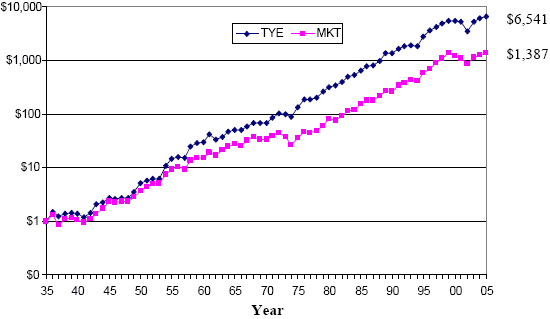Cycles, whether empirical or tied to economic/political fundamentals, are a recurring theme in efforts to predict financial markets. Is there a two-year cycle for the stock market? In his August 2008 paper entitled “The Two-Year Effect”, Graham Bornholt investigates a two-year reversion effect in the U.S. equity market. He defines low and high stock market return years, from which reversion occurs, relative to a lagged 10-year moving average of annual market returns. Using value-weighted annual returns from broad samples of stocks during 1871-1925 for in-sample model specification and during 1926-2005 for out-of-sample testing, he concludes that:
- When a broad value-weighted U.S. stock market index is weak (strong), relative to its lagged 10-year moving average, the average return two years later is +18.7% (+7.1%). This 11.6% difference is statistically and economically significant.
- Simple regressions do not reveal this anomaly because the relationship between past and future returns is non-linear.
- The difference in returns two years after weak and strong value-weighted index returns varies reliably by market capitalization, ranging from 10.6% for the largest firms to 23.3% for the smallest.
- This anomaly is:
- Not concentrated in January.
- Not driven by depression-era returns.
- Not weakening over time.
- Largely driven by the reversion behavior of large capitalization stocks.
- Not explained by the business cycle or the four-year U.S. presidential election cycle.
- The best explanation for the anomaly may derive from the notion that investor risk aversion systematically cycles as the market swings up and down.
The following chart, taken from the paper, compares the cumulative values of initial $1 investments at the start of 1936 in a Two-Year Effect (TYE) strategy and a strategy of buying and holding the broad value-weighted stock market (MKT strategy). The TYE strategy is:
- 150% invested in the value-weighted market index when the anomaly predicts high returns, assuming leverage costs of 1% over the risk-free rate.
- 50% invested in the value-weighted market index and 50% in cash (at the risk-free rate) when the anomaly predicts low returns.
During 1936-2005, the TYE (MKT) strategy earns an average return of 15.0% (12.4%), with standard deviation 17% (17%) and Sharpe ratio 0.65 (0.50).

In summary, investors may be able to exploit a two-year reversion effect signaled by past returns of the broad value-weighted U.S. stock market.